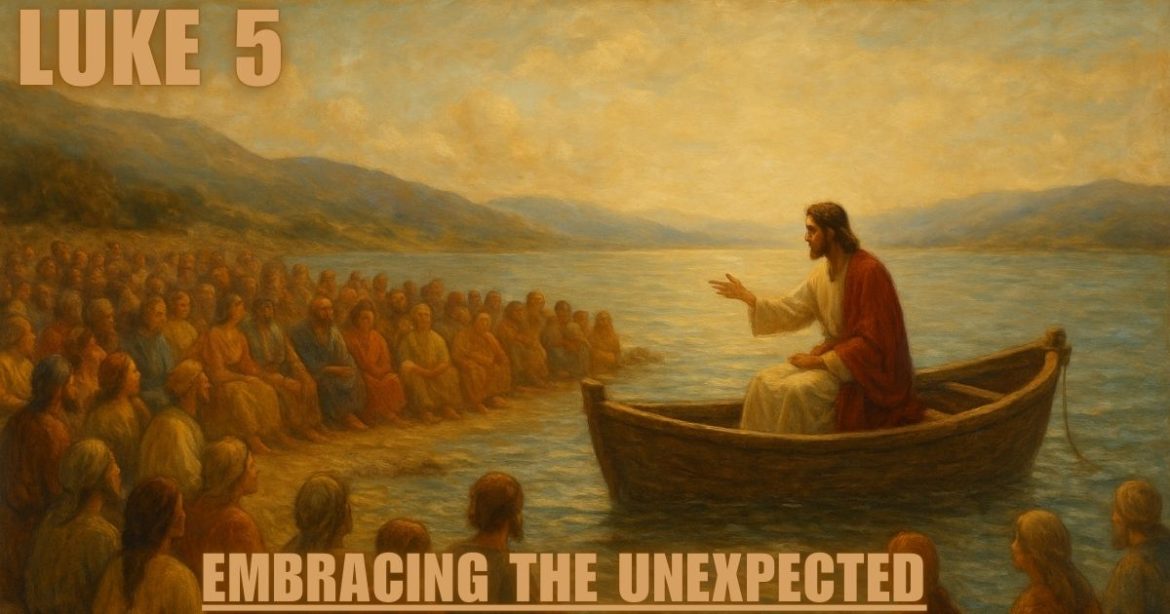Have you ever wondered why Jesus chose fishermen over scholars? Luke 5 gives us a rich look into the heart of Jesus’ ministry—how He uses the ordinary to accomplish the extraordinary. This chapter reminds us that no matter who we are or what we bring to the table, God can use us in powerful ways. It’s a message that remains as relevant today as it was two thousand years ago.
The Setting: Crowds, Boats, and a Purpose
Luke 5 opens with a dramatic scene: Jesus standing by the Sea of Galilee, pressed by crowds eager to hear His teaching. To create space and amplify His voice, Jesus steps into Simon Peter’s fishing boat. This small act is loaded with symbolism—Jesus using an ordinary tool for an extraordinary purpose. Whether it’s a boat, a microphone, or a keyboard, what we have can become a vessel for God’s work.
From Fishermen to Fishers of Men
After teaching, Jesus instructs Peter to cast the nets once more. Despite a night of fruitless fishing, Peter obeys—and the nets overflow. This miraculous catch isn’t just about fish; it’s about transformation. Peter, recognizing his own unworthiness, falls at Jesus’ feet. Jesus’ reply, “Do not be afraid; from now on you will catch people,” signals a pivotal shift: these common fishermen are now called to be the first disciples, tasked with bringing souls to God.
Healing the Outcast: Compassion Beyond Comfort
Next, Luke recounts Jesus healing a man full of leprosy. At the time, lepers were outcasts, considered spiritually and physically unclean. By touching the man, Jesus not only healed his disease but restored his dignity. This act of compassion underlines an essential teaching: no one is too broken, too dirty, or too outcast for God’s love.
Forgiveness and Authority: The Paralyzed Man
The story of the paralyzed man lowered through the roof highlights another layer of Jesus’ ministry: the forgiveness of sins. Healing physical ailments was miraculous, but the true miracle was the restoration of the soul. Jesus demonstrated His divine authority to forgive, challenging the religious leaders and redefining what it meant to be whole.
A Table for Everyone: Dining with Sinners
Jesus calling Levi (Matthew), a tax collector, and dining with sinners was a scandal to religious authorities. Yet it perfectly captured Jesus’ mission. He came not for the self-righteous, but for those aware of their need. In doing so, He showed that God’s kingdom is open to all, regardless of social status or past sins.
Joy in the Presence of the Lord
When questioned about fasting, Jesus used the imagery of a wedding celebration to explain that His presence among them was a time for joy, not mourning. This joyful presence would eventually give way to sorrow, but for now, it was a season of hope and celebration.
New Wine, New Wineskins: Embracing Transformation
Jesus’ parable about new wine and new wineskins is a metaphor for the radical shift He was bringing. Old structures could not contain the new life and freedom He offered. Likewise, our hearts must be flexible and open to the transformative work of Christ.
Applying Luke 5 to Modern Life
- Use what you have for God’s glory: Whether it’s a skill, a resource, or a platform, God can use it.
- Recognize your worth beyond worldly standards: Jesus calls ordinary people to extraordinary purposes.
- Extend compassion to the outcasts: No one is beyond redemption.
- Celebrate the presence of Jesus daily: Joy is a natural response to His love.
- Be ready to change: Let Jesus create new wineskins in your heart, making room for His transformative work.
Conclusion: Luke 5 reminds us that God doesn’t call the qualified; He qualifies the called. Whether we feel like simple fishermen or outcasts, Jesus looks at our hearts and invites us to follow Him. As we walk with Him, He uses our ordinary lives to accomplish extraordinary things. Let’s embrace that calling, love others with His compassion, and always keep our hearts open for His transforming work.

